
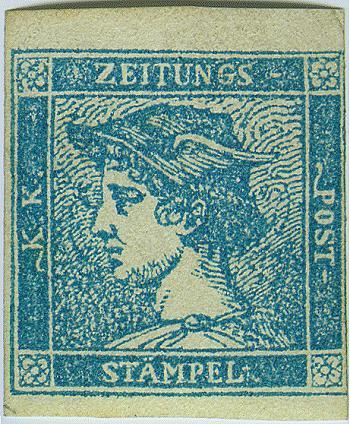
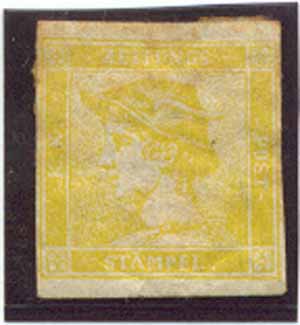


Return To Catalogue - Austria Newspaper stamps of 1858 and later - Austria overview
Note: on my website many of the
pictures can not be seen! They are of course present in the cd's;
contact me if you want to purchase them: evert@klaseboer.com.
(0.6) k blue (Blauer Merkur) (0.6) k yellow (Gelber Merkur) (6) k red (Rosa Merkur) (30) k orange (Zinnober Merkur, rarest stamp of Austria)
These stamps are the first newspaper stamps in the world and
were issued on the 1st January 1851 (except the orange stamp).
They could also be used in Austrian Italy.
The blue stamp was intended to be used for one newspaper, the
yellow stamp for 10 newspapers and the red (rosa) stamp for 50
newspapers. The rosa stamp wasn't used very much and it was
decided in October 1852 to use it as if it was a blue stamp (most
of the red stamps are used as such). The design on the yellow
stamp was badly visible and forgeries made by chemical means from
the blue stamp appeared. It was therefore decided to introduce
the orange stamp (zinnober or zinnoberrot in German) in March
1856. The remaining yellow stamps were used up as blue stamps
(for one newspaper). The orange stamp was in little demand and
was declared invalid on 31 December 1858. Most of these stamps
were thrown away with the newspapers, and especially the orange
stamp has become a mayor rarity. Source: http://www.extrafast.de/articles/564696.html
(in German).
For the specialist: Three types exists of these stamps. The blue
stamp was printed in all three types. The yellow and red stamp
were printed only in type I. The orange stamp was printed in type
III only. In type I the 'G' of 'ZEITUNGS' has no crossbar and the
dots on 'A' of 'STAMPEL' are evenly placed on the 'A'. In type II
the 'G' also has no crossbar, but the right dot on the 'A' is
placed sligthly more to the left, so the two dots are closer
together. In the last type, type III, the 'G' has a crossbar and
the 'A' is as in type II. Most of these stamps are rare, since
they were thrown away, together with the newspapers.
Value of the stamps |
|||
vc = very common c = common * = not so common ** = uncommon |
*** = very uncommon R = rare RR = very rare RRR = extremely rare |
||
| Value | Unused | Used | Remarks |
| blue | RR | R | Number of stamps printed: 136000000 Cheapest reprints: * |
| yellow | RRR | RRR | Cheapest reprints: *** |
| red | RRR | RRR | Cheapest reprints: *** |
| orange | RRR | RRR | Number of stamps printed: 120000 Cheapest reprints: *** |
The forgery below is probably a Spiro forgery. The front of the tunic starts at the 'T' of 'STAMPEL'. In the genuine stamps, the front of the tunic starts before the 'S'. There is a '.' instead of a '-' after 'ZEITUNGS' (this is not visible in the stamp below, however). (information taken from 'the Spud Papers'). I have only seen these forgeries with the cancel dots in a square as shown below or uncancelled. Fournier also sold these Spiro forgeries (second choice as he offered them), he offered the four values for 1 Swiss franc (in his 1914 price list). I've seen red, blue and yellow Spiro forgeries.





Spiro forgeries. This is also the first forgery described in
Album Weeds. They are usually cancelled with a pattern of dots,
but more 'improved cancels' exist.
Fournier forgeries:


Fournier forgeries as shown in the Fournier Album (reduced
sizes).


Fournier forgery with forged Breitensee and Wien cancels
Besides the Spiro forgeries, Fournier also offered better forgeries (1st choice as he offered them); the five values (I don't know what the fifth stamp is supposed to represent, maybe one of the types of the blue stamps?) for 5 Swiss francs (also from Fournier's 1914 price list). There is a bright white spot in the internal lower left frame. Some of the subtypes have a dot instead of a line behind 'POST'. According to the site: http://forgeriesofitalianstates.com/Lombardy/Lombardy.htm the dots are missing on these Fournier forgeries. It seems that the following cancels were used on these forgeries:

Fournier cancels, reduced sizes
'HAID 18/4 56' in a single circle
'RADOTIN 6/12 50' in a single circle
'9 -11 N WIEN 2 III' in a single circle
'JUNGLINSTER 13/12 87 6-7 M.' in double circle (this cancel is
actually a cancel used on forgeries of Luxemburg)
'EKENAS APR 8 1856' in a rectangle
'BREITENSEE 17/12 52' (listed under Mecklenburg-Schwerin)

Page from a Fournier Album; the second red stamp has the RADOTIN
6/12 50' forged cancel. The second yellow strip are actually
Spiro forgeries.
Other forgeries exist, examples:


The background and corner ornaments are quite different in the
above forgeries. In my opinion, the oblique shading lines in the
left bottom central rectangular area do not appear in the genuine
stamps. Furthermore, the margins around the stamps are too large.
I've also seen blocks of four of these forgeries including the
blue stamp. The top of the ear is missing and the mouth is quite
short.



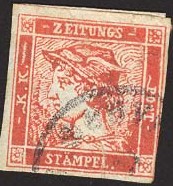
Some forgeries made by the same forger; The front of the tunic
starts at the end of 'S' of 'STAMPEL'. In the genuine stamps, the
front of the tunic starts before this letter. Also, the
background is too dark at the right hand side. The cancel
consists of a circle with unreadable letters on these forgeries.
This is most likely the second forgery described in Album Weeds.


Two forgeries with the 'S' of 'STAMPEL' very strange, the face of
the figure is also different.

(Forgery, reduced size)


Primitive forgery of the red stamps with very broad white band on
wing and lettering too large; the back of the head is outlined
with a white line. The cancel appears to be printed on it.



Forgeries with an even wavy background. The letters 'K.K.' are
printed upside down. This is the third forgery described in Album
Weeds.

Rather deceptive forgery with a 'VENEZIA' cancel. I have seen
another forgery of this type with the same cancel (in the Carl
Kane collection auctioned with Rumsey Auctions). The word
'ZEITUNG' is too fat and there is no '-' behind it. The ear is
too thin. The 'P' of 'POST' is too fat. The background design is
different (for example in the upper right corner).



Other forgery with different lettering and slightly different
background pattern; the wing on the hat is almost straight at the
top instead of curved. In the middel such a red forgery with
cancel 'ZEITUNGS - EXPED. WIEN 6/10' in a circle cancel. At the
righ hand side a blackprint or 'Schwarzdruck' of this particular
forgery. The dots behind 'K.K.' are too big.

A forgery with cancel 'ZEITUNGS EXP 31/10 9 U.' in an ellipse

Another set of forgeries.

Forgery of the blue stamp with a very clear ear. The white lines
on the hat and the wing are also very clear. I've seen blocks of
four stamps of this forgery (printed very wide apart).

Other primitive forgery



Some kind of forgeries or reprints, even in the color grey.
The forger Sigmund Friedl has made forgeries of the 'Zinnoberroten Merkur' stamp. He pretended to have 'found' a large number of these stamps in 1890. Another lucky find in 1895 enabled him to offer all three rare colors. He also offered genuine blue newspaper stamps with his forged cancels applied to it (see http://www.philaforum.com/forum). If my information is correct this is a photo-lithographed forgery. It exists unused and with cancel:

Friedl forgery, image obtained from: http://de.wikipedia.org/wiki/Sigmund_Friedl,
with cancel 'Bregenz 1.APR.'

On this forgery, Friedl made a mistake in the cancel by writing
'LESPEDIZIONE' while it should have been 'I.R.SPEDIZIONE': source
http://www.philaforum.com/forum
His cancels were apparently much less
'convincing' than his forgeries (he might have even used genuine
printing plates). The cancels he used were (http://www.philaforum.com/forum/):
"Zeitungs -Exped. Wien" (double circle cancel)
"Bregenz" line cancel without box
"Bregenz" as above, but in italic
"Trieste" in two rings
"Venezia" line cancel (slanting text)
"Milano" boxcancel
"Como" single circle cancel
"Vicenza" ringcancel

A set of forgeries, made by the same forger.
The forger Sperati has made forgeries of the yellow, red and orange stamps. He sometimes used genuine (blue?) stamps on which he removed the image and printed a new image.
First Sperati forgery (red and yellow stamps):
This forgery type is rather blur. For example the 'Z' of 'ZEITUNGS' is rather weak (both horizontal lines are almost invisible), similar remarks can be made for the 'E' and 'T' of this word. The second 'K' of 'KK' has its top part missing. Sperati sometimes used genuine stamps with genuine cancels to print his forgeries on.



Red and yellow Sperati forgeries, the cancel 'VENEZIA I.R.
SPEDIZIONE GAZETTE 4/25' was also forged by him. I believe the
'TRIESTE' cancel on the yellow forgery is genuine.
Sperati seems to have two types of the 'VENEZIA I.R. SPEDIZIONE GAZETTE' cancel; one with diameter 21 mm (with dates 1/25, 2/25, 2/31, 4/10 and 4/25) and another with diameter 40 mm (with dates 18/4 and 10/2). For an example of the larger sized cancel, see under the second type forgery. Source: 'The work of Jean de Sperati' by the BPA (1955).

Yellow Sperati forgery on a small piece of a newspaper with
cancel 'WIEN ZEITUNGS- EXPED 20/12'
Sperati seems to have the above 'WIEN ZEITUNGS- EXPED' cancel with several dates: 20/2, 17/10, 10/11, 18/11, 1/12, 10/12, 17/12 and 20/12.
Second Sperati forgery (orange stamp):
Sperati used forged cancels on this second type of forgery.

Sperati forgery

Sperati forgery with forged 'GRATZ 1 8' red cancel. On http://www.seymourfamily.com/rfrajola/Sperati/AUS02_300.jpg
a similar forgery with the same cancel can be found.

Samples of all the cancels that were used by Sperati for Austria.
The cancels that Sperati used are (besides the
ones already mentioned under the first type of forgery):
'LINZ 18/6 V-VIII' (see image above)
part of a blurred 'ROVERETO' cancel (some kind of seal, see the
two images above).
'EITUNGSEXPED 8/8' (I haven't seen this cancel yet on a forgery)
I've seen some forgeries of these stamps on (genuine?) old Italian Newspapers, often with very fancy cancels. Examples:


Yellow stamp with 'Millwheel' cancel and blue stamp with cancel
'DISTRIBUZIONE' in a double circle with large '2' in the center
For more of these Italy States and Austrian forgeries on old documents, made by the same forger, click here.
The forger Peter Winter also has made forgeries of these stamps (produced around 1980):






(Peter Winter forgeries)
I posess Winter forgeries of all 4 stamps, the yellow stamp has cancel 'STEYR 17/11' in a single circle, the red one 'PESTH 5/3' in a rectangle and the orange one a double-circled postmark 'ZEITUNGS EXPED. LAIBAICH 12/12'. As can be seen above the 'PESTH 5/3' cancel was also applied on the yellow stamp. Also can be found: 'ZEITUNGS EXPED. WIEN 20/11' and ' WIEN 3/3 6 A'. These forgeries were even offered on pieces of newspaper, but also uncancelled. The outline of the face is badly done.
Modern forgeries exist, I presume that the next stamps are such modern forgeries:
Reprints also exist (see http://www.kitzbuhel.demon.co.uk/austamps/reprints/ for more information).
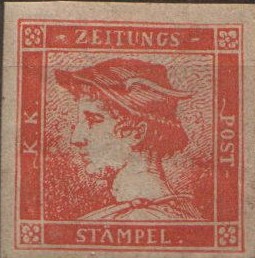
I've been told that this is a reprint made in 1866.
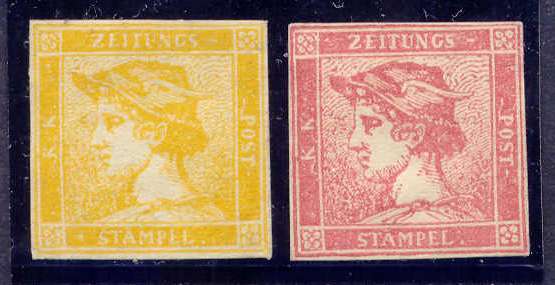
(Examples; two Fellner reprints, made in 1885)
The above reprints were made by Ernst Fellner (in 1885?). I don't think these reprints are very common.
WIPA reprints (1933):
Note: many forgeries of this issue exist! Stamps with inscription 'WIPA' on top and '1933' at the bottom are from philatelic exhibition in Vienna in 1933. Nine shades of colour were issued in sheets of 16 stamps each: light brown, orange, light red, dark red, lilac, violet, green, light blue and dark blue. Cancelled 'Wipa' stamps also exist:

(Cancelled 'WIPA' stamps, reduced sizes)
Austria Newspaper stamps of 1858 and later